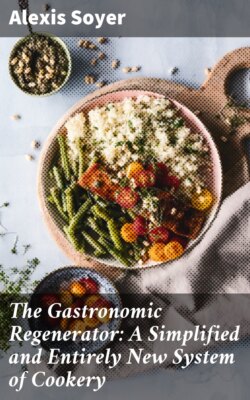Читать книгу The Gastronomic Regenerator: A Simplified and Entirely New System of Cookery - Soyer Alexis - Страница 12
На сайте Литреса книга снята с продажи.
THE TENDON SEPARATOR
ОглавлениеTable of Contents
Is represented shut when done with, by merely slipping the brass ring to keep the spring in its place, and open when in the act of being used; the straight part of the handle, with the ring, resting in the palm of the hand between the thumb and the fore-finger. When about separating the tendons and otherwise dividing other parts of your fowl or bird, you begin by turning the skin over the wings and cutting the tendons (No. 1, p. xxiv) in each of the joints; and then by taking hold of that part commonly called the drumstick with your right hand and the skin being already turned, you can easily get at the joint (No. 2) by making it come out, to cut the tendons of each leg; on turning the Separator with the points upwards, you give a cut at the breast-bone (No. 4); and, by holding the instrument with both hands, immediately after turning the points downwards, you also give a cut at the back-bone (No. 5), and then, the four tendons being cut, the limbs are brought back to their former position. Then you introduce the instrument into the body at the other end of the bird, and with your left hand you take hold of the thigh-bone, which you also divide at No. 3, and again turning the points downwards, you give another cut at the back-bone No. 5; with little practice the cuts at the breast and back-bone, are made without interfering in the least with the skin; then you truss the bird in the common way, but a packing-needle and thread are to be preferred, as explained at page xv. When roasted, the appearance of the poultry is vastly improved by this simple operation, it looks more plump on account of the sinews having lost their power of contraction whilst roasting; therefore, when the bird
comes to table, the carver has merely to pass the knife in the usual manner to take up the wings and legs, and finds no resistance; the same at the breast and the back, where it may easily be seen whilst carving that it has already been prepared.
Three minutes is about the time taken by this new process to cut into ten parts an ordinary fowl.
For a Turkey or a Goose, the sinews are divided as above, and in the act of carving, instead of cutting the fillets in a straight line with the breast-bone, you separate them obliquely, and all other parts as usual.
Pheasants, Ducks, and all Wild Fowl especially, must be prepared in a similar manner.
A Hare or Rabbit may also have the sinews and back-bone divided; to effect this you lay the hare upon its back, and give six cuts nearly through the back-bone, holding the Separator with both hands, through the belly part; then you truss it for roasting. If it should happen to be a very large hare, the fillets only are carved, and they ought to be cut in thin slices in an oblique direction, instead of straight along the back.
The half of a Fowl with the flesh on. The half of a Fowl dissected.
